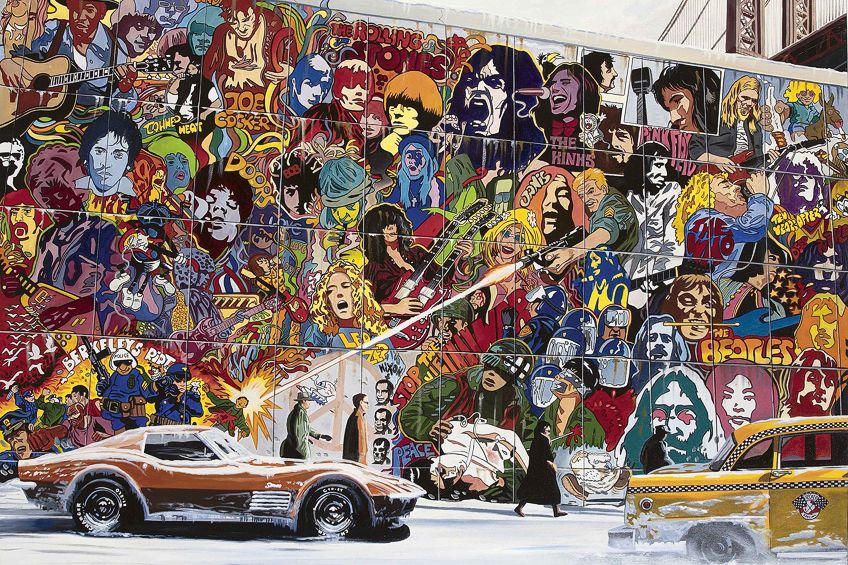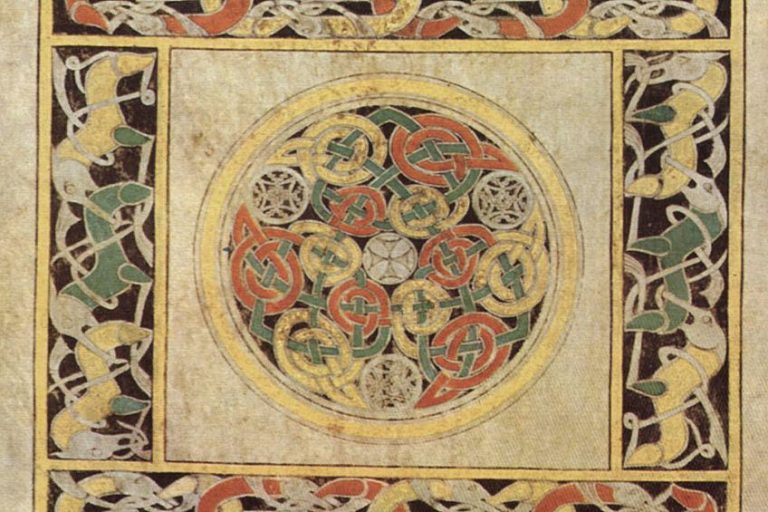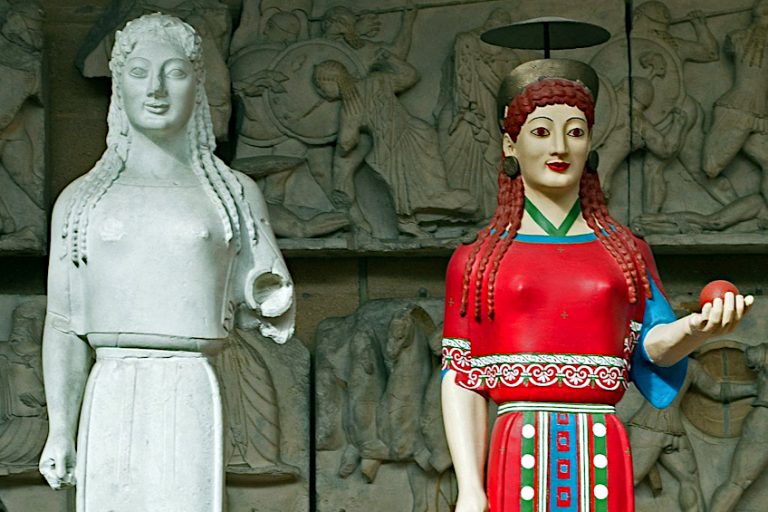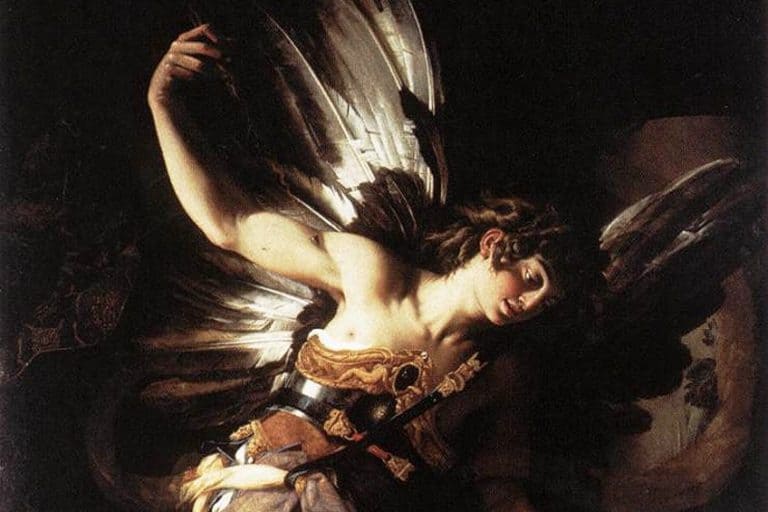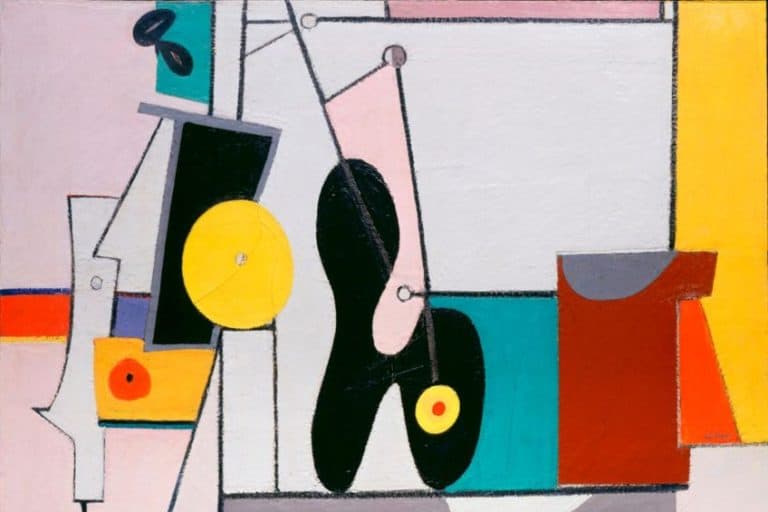Psychedelic Art – An Exploration of the Psychedelic Aesthetic in Art
Originating in the mid-1960s, Psychedelic Art was a graphic art form that created visual displays inspired by the experience of psychedelic drugs and hallucinations. Also known as psychedelia, artworks created typically featured a full spectrum of vivid colors along with cartoons and animation in order to provoke a type of psychedelic experience when looking at the work. The evolution of Psychedelic Art is considered to be a direct predecessor to the development and subsequent popularity of all imaginative art that is in existence today.
What Is Psychedelic Art?
Psychedelic Art refers to all artistic creations emerging from the late 1960s that attempted to portray the inner world of the psyche through incredibly graphic and visual depictions. In doing so, art that appeared to be recreating experiences and hallucinations that were common after ingesting psychedelic drugs such as LSD and psilocybin were known to be “psychedelic”.
The term “psychedelic” was conceived by British psychologist Humphry Osmond after his extensive work with psychedelic drugs. Osmond stated that the word was used to imply a type of “mind manifesting” that occurred after the consumption of drugs, with his term going on to represent the emotions felt after viewing psychedelic artworks. Psychedelic is also a concept derived from the Ancient Greek words “psychē”, meaning “soul” and “dēloun” which means “to reveal.”
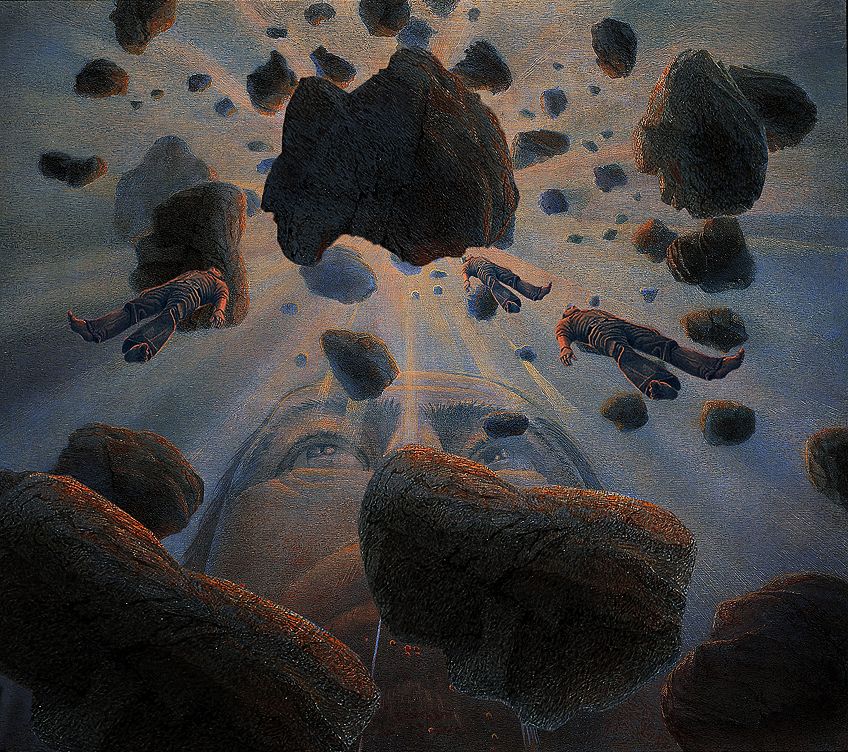
In addition to the experience of viewing Psychedelic Art, the name of the genre made reference to the drugs that were popular within the youth culture at the time of the movement’s peak. Artworks that emphasized incredibly distorted and almost surreal qualities through the use of excessive color were considered to be psychedelic, as they were thought to depict the inner workings of the mind.
Within the Psychedelic Art period, a variety of different creative mediums were taken into account along with artworks. This included rock music, album covers, concert posters, murals, comic books, and liquid light shows to name a few. Despite all belonging to the creative world, these art pieces were connected by their common attempt to create kaleidoscopically swirling patterns of color that evoked LSD-type illusions.
This trippy art informed the idea that modified levels of awareness produced by psychedelic drugs were actually a source of artistic inspiration. Furthermore, the development of Psychedelic Art was thought to be radically progressive, as artworks made touched on many pertinent political, social, and spiritual issues that made up the 1960s era.
The History of Psychedelic Art
The origins of Psychedelic Art are said to relate back to the discovery of LSD by Albert Hofmann in 1943. Hofmann was researching potential derivatives from lysergic acid and began synthesizing LSD, in an attempt to obtain a respiratory and circulatory stimulant that had no repercussions whatsoever on the uterus. After setting the drug aside for a period of time, Hofmann began re-experimenting with the drug and accidentally absorbed a small amount of it, which led to him discovering the potent effects it had.
The development of psychedelics allowed artists and poets to explore, with this new form of trippy art being quickly and fully accepted into art communities. This was because artworks stood for more than just mere visual representations of artists’ hallucinatory experiences, as the artworks experimented with numerous visual styles and corporate advertising techniques synonymous with the 1960s. While many associate Psychedelic Art with drugs and rock music, this art form was present before psychedelic rock even appeared on the music scene.
Psychedelic Art thus supported the notion of creating works that defied traditional limitations associated with formal art, which was something that many artists in previous movements had tried out. Heavily inspired by the previous movement of Art Nouveau, which protested the revolutionary changes associated with the Industrial Revolution, the Psychedelic aesthetic adopted the concept of rebellion within artworks created and disputed the military-industrial complex of the 1960s.
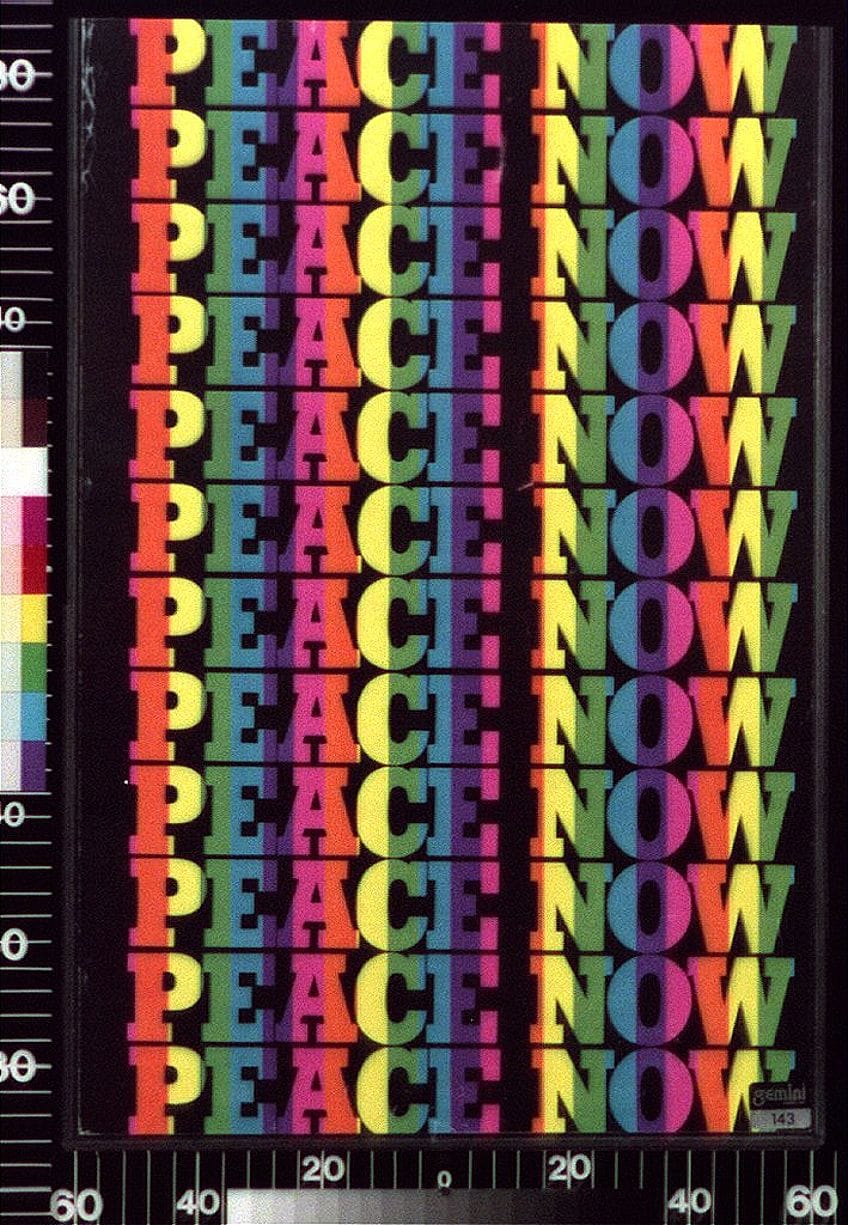
Viewed as an alternative to mainstream design, artists borrowed elements from other styles and included psychedelic patterns and drawings so that it emerged as a completely new form of art. Artworks made using this Psychedelic aesthetic favored intensely contrasting colors that had the ability to make viewers’ eyes vibrate after looking at the work, which was a clear reference to an LSD trip. The frameless technique of psychedelic drawings also imitated the experience and mind-altering state associated with a high.
Artists embraced the emergence of Psychedelic Art, as it existed as one of the first truly liberating movements that gave artists the liberation they craved from traditional art society. Artworks created during this time mirrored the type of freedom that only drugs could provide, which allowed artists the opportunity to openly explore different avenues in order to find their inspiration.
However, this connection between trippy art and hallucinogenic drugs was not always well received, which led to strong criticisms of the art style itself. Some critics thought that artists were simply recreating their own visual experiences of taking drugs, which gave their art very little aesthetic value.
Despite these critiques, some individuals were a lot less judgmental of the psychedelic aesthetic as a whole, which allowed them to identify the association between Psychedelic Art and other iconic genres like Art Nouveau, Op-Art, and Surrealism.
Op-Art proved to be a big influence on the development of Psychedelic Art, as the style achieved significant success through exploiting the principles of optics and illusions, which made artworks appear to be vibrating and moving. Another great influence was the Pop Art movement, which promoted the expanding culture of commodity and created mass reproductions of identical and well-known images. Both of these artistic genres were crucial predecessors to the budding Psychedelic Art scene, as they had a major impact on its style.
The 1960s Psychedelic Art movement made a strong impact on comic book artists at the time, who went on to create an alternative and revolutionary type of comic book art that became known as “Underground Comix.” The creation of comic art also led to the emergence of concert posters and record album covers for bands and artists such as The Who and Jimi Hendrix, with Psychedelic Art being seen as a major influence in the development of these artistic expressions.
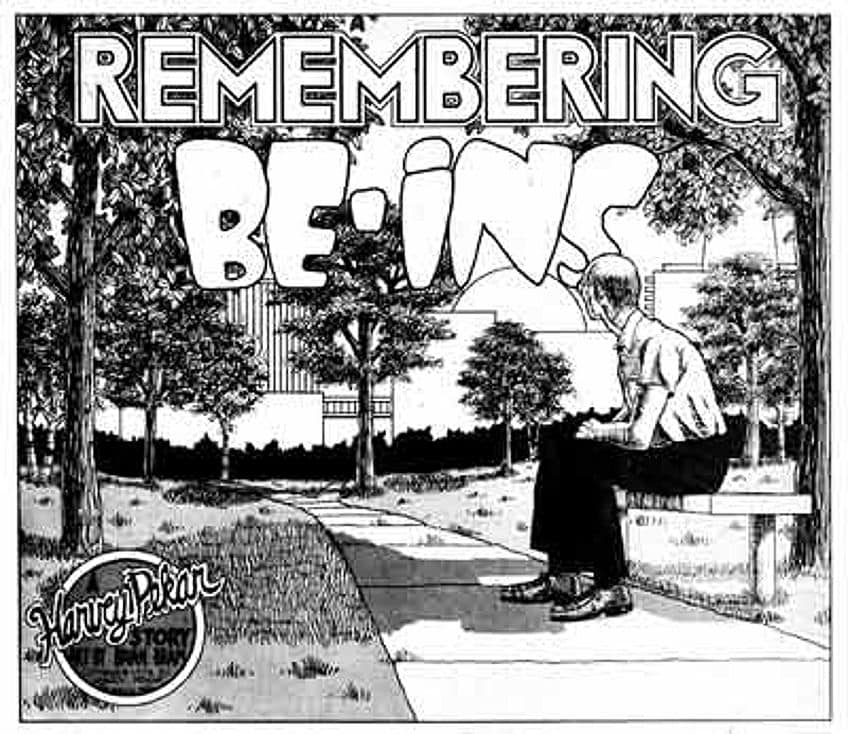
Both comic book art and music-related art made use of the iconic traits typically associated with famous Psychedelic works, which were very satirical in nature. Psychedelic Art was described to have a visually captivating quality despite some individuals believing the art to seemingly promote the use of illicit substances. As Psychedelic Art was associated with drug culture, music festivals such as Woodstock became a typical example of the type of psychedelic drawings and posters that were created using this trippy art style.
The early examples of Psychedelic Art were more literary than visual but after movements such as Surrealism, the genre slowly morphed into a more visual medium. With the development of Psychedelic Art picking up as the digital age was further explored, this 1960s aesthetic has gone on to make its mark within popular culture, design, and corporate advertising.
The notion of an altered state of consciousness is essentially what fueled the Psychedelic Art movement, as a variety of visual styles were exploited in order to recreate kaleidoscopic-type hallucinations.
Psychedelic Art went on to influence numerous aspects of popular culture, such as lifestyle, language, literature, philosophy, art, music, and clothing throughout its dominance and is considered to be one of the most visually exploited styles in design.
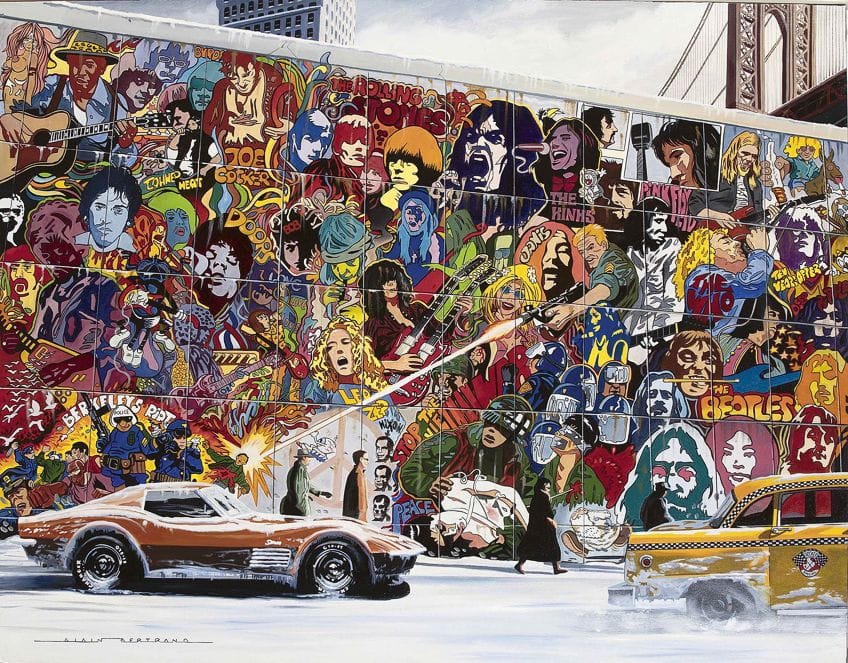
Psychedelic Counterculture Art of the 1960s
The counterculture movement during the 1960s was an anti-establishment cultural sensation that developed throughout the Western world for approximately 10 years. The movement gained traction during the Civil Rights movement in America and developed in response to the radical expansion of military involvement during the Vietnam War. As thoughts and ideas began to grow in response to increasing experimentation with psychoactive drugs, Psychedelic Art emerged as a major result of counterculture art.
The evolution of 1960s Psychedelic Art addressed concerns relating to the political and social values that became apparent in post-war America. The baby-boom generation was credited with the creation of Psychedelic Art and the broader psychedelic movement that featured in other artistic mediums. This group of individuals began protesting against the cultural values that were upheld by older generations, such as the complete acceptance of segregation, war, and the societal codes of capitalist and materialistic governing America during the 1950s.
Counterculture quickly rejected mainstream culture in favor of establishing a newer and more notable culture. This was done through focusing attention on eastern spirituality and openly exploring recently discovered sexual liberation at the dawn of the 1960s. The contribution of new music genres proved notable to the development of the counterculture era, with psychedelic rock quickly becoming the leading genre of music, accompanied by countless concert posters and album covers rendered in the unique psychedelic illustration style.
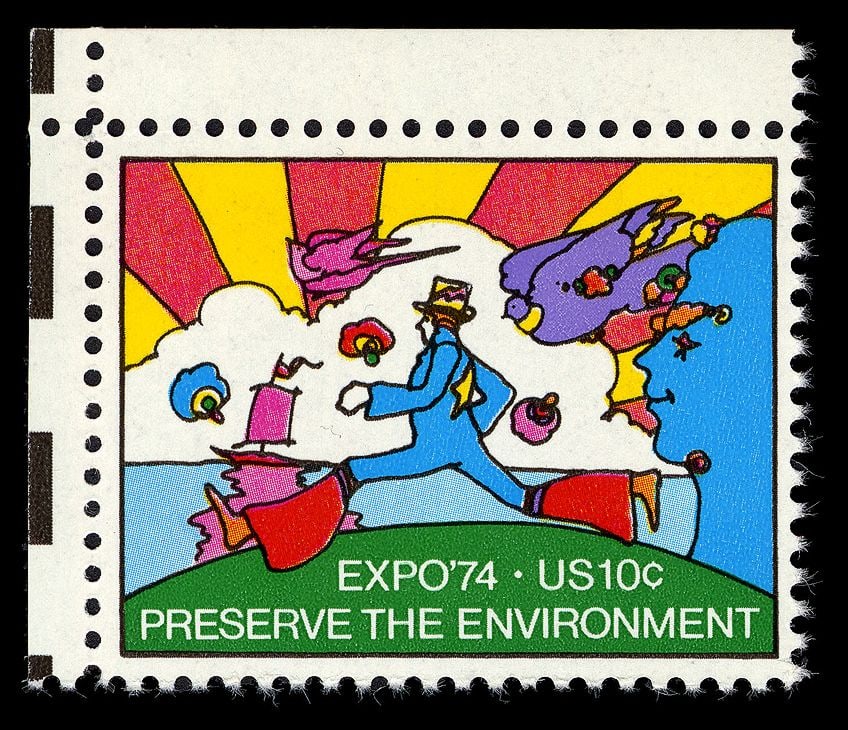
The 1960s Psychedelic Art counterculture movement led to the development of the best poster artists to come from this era, which included the works of San Francisco artists Peter Max, Wes Wilson, and Victor Moscoso. These artists, in addition to a host of others, went on to create some of the most important and iconic examples of Psychedelic drawings to emerge from this period of artistic creation. The drawings and illustrations created by these artists thus went on to shape an entirely new generation of emerging musicians and their cover art.
While counterculture was automatically associated with the hippie community of the 1960s and 1970s, it allowed the Psychedelic Art scene to grow and expand until it developed internationally. While San Francisco remained the hub of Psychedelic Art in the 1970s, the style had reached the United Kingdom and began to influence Op-artists who started to include psychedelic designs that created optical illusions in their artworks.
While critics were quick to discard the movement in terms of its aesthetic value, Psychedelic Art was not as insignificant as it was initially made out to be. The movement played a predominant role in the appearance and domination of counterculture throughout this era, which added to its widespread acceptance and subsequent success.
Psychedelic Art in Corporate Advertising
By the time the late 1960s rolled around, the commercial possibilities linked to Psychedelic Art were very difficult to overlook. Corporate advertising during this time typically featured Psychedelic drawings and themes that included a multitude of colors so as to stay relevant with the developing culture at the time. However, a strong divide was made clear between the products and the corporate image, with the psychedelic features often being kept at an arm’s length away from the professional representation to make the distinction clear.
This was done to emphasize that not all companies embraced the features of the new psychedelic era, with a great contrast becoming evident within certain advertisements and the respective businesses. Commercials containing swirls of color to imitate an LSD trip were kept separate from the neutrally structured and businesslike logos of companies to highlight the notion that not every company agreed with the beliefs pertaining to the psychedelic aesthetic.
Despite the mixed emotion attached to the rise of Psychedelic Art, some companies explicitly associated themselves with the aesthetic. Among those companies that seemed to approve of psychedelia within their advertisements were Neiman Marcus, the department store, and the broadcasting companies CBS and NBC, who all ran commercials featuring psychedelic elements between 1968 and 1969.
A more overt reference was made by Campbell’s in 1968, who revealed a poster that read “Turn your wall souper-delic!” to promote their soup. This poster included two individuals dressed in brightly colored clothes that featured swirling and trippy patterns, with vivid psychedelic colors painting the background.
When viewing the advertisement, it became automatically associated with the Psychedelic Art era due to the elements included and demonstrated that some companies had begun to change their mindset in relation to this style.
By the early 1970s, more advertisers had begun to use features of Psychedelic Art in an attempt to sell countless consumer goods. Items like cars, cigarettes, hair products, and pantyhose were subjected to kaleidoscopic acts of mock rebellion in the advertisements made. Through all of the works created by artists, designers, and writers during the era’s development, Psychedelic Art had undergone a great semantic shift and suddenly came to symbolize anything within youth culture that was cool, unique, and incredibly fashionable.
The term “psychedelic” itself underwent a distortion, to the point where multiple companies began jumping on the bandwagon to pitch their products in the most applicable way to their psychedelic-crazed target groups. This led to the Psychedelic Art movement being widely incorporated by mainstream commercial powers by the mid-1970s, which integrated the exact system of capitalism that the hippie movement had fought so tirelessly against to move away from.
Today, the reason that we consider Psychedelic artwork to be so kitschy and garish is due to its intense presence within corporate advertising.
Through the 1960s and 1970s, the concept of Psychedelic Art underwent a great shift in its understanding and marketability, to the point where it morphed from a completely outrageous movement to something that was included in nearly every advertisement seen. The features of Psychedelic Art were edited to fit into consumerist America, which went on to strip the movement of what it originally stood for.
What Are the Characteristics of Psychedelic Art?
Peaking between 1966 and 1972, Psychedelic Art featured many fundamental characteristics that quickly became associated with the style. Most artworks went on to depict a vividly strong color palette typically made up of contrasting colors, along with flamboyant lettering and multicolored swirls. Color juxtaposition became a primary characteristic within Psychedelic Art, as it led to the formation of other optical illusions and somewhat illusive geometric lines.
Other major characteristics that were found within the Psychedelic aesthetic were spirals that seemed kaleidoscopic in nature, concentric circles, paisley patterns, and repetitions of motifs or symbols until a pattern was formed. Collage also formed an important component in Psychedelic Art, as many artworks could also have been incorporated into the collage genre due to their style.
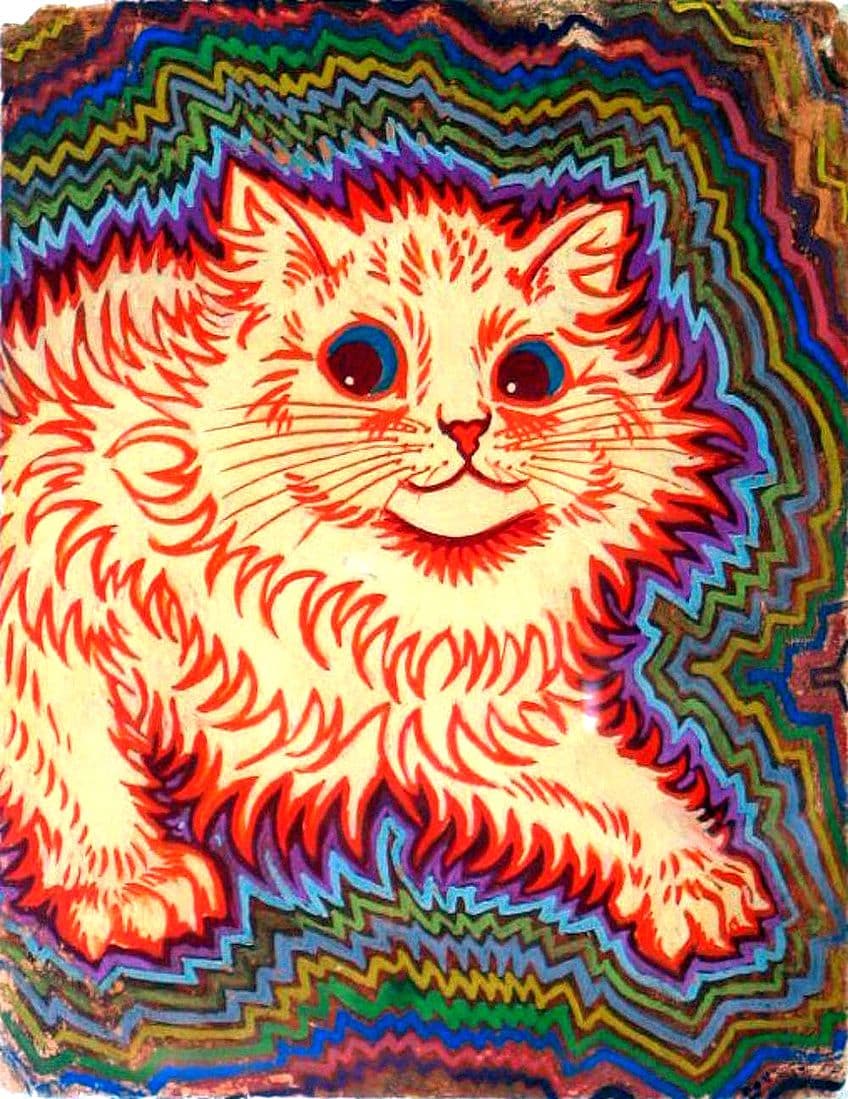
The subject matter used within the 1960s Psychedelic Art genre tended to lean more towards the fantastic, abstract, and surrealist side of artistic expression. Extreme detail was paid to the artworks made, which led to the creation of incredibly innovative and groovy typography and hand-lettering styles. Artists frequently made use of positive and negative spaces within Psychedelic Art, which went on to become another key characteristic of the movement.
The Psychedelic Art movement looked to a variety of other genres and styles for inspiration while it was developing. It is no coincidence that the artworks to emerge from the Psychedelic era reflected elements taken from the Art Nouveau, Victorian Secession, and Surrealist era, as these styles greatly influenced the developing characteristics of Psychedelic Art.
Famous Psychedelic Artists and Their Artworks
The Psychedelic Art movement was a popular style that developed in relation to the counterculture era in America. The era led to many artists practicing and experimenting with this exciting new movement. However, some artists managed to stand out above the rest due to creating unbelievably significant artworks, which we will discuss below.
Victor Moscoso (Born 1936)
Spanish artist Victor Moscoso is a professional graphic designer who is best known for his production of psychedelic rock posters, advertisements, and his involvement in “Underground Comix” in San Francisco throughout the 1960s and 1970s. Moscoso became the first Psychedelic artist to branch into the creation of rock posters, making use of multiple photographic collages in order to create a distinct style. Some of his iconic works include Big Brother and the Holding Company (1967) and The Chambers Brothers (1967).
Moscoso’s professional success as an artist came from his psychedelic rock posters. He quickly borrowed elements from comic books and commercials when creating posters, with his artworks going on to gain international attention at the 1967 “Summer of Love” event.
What makes Moscoso’s works so unique is his use of vibrating colors, influenced by one of his art teachers from Yale University. Moscoso attempts to recreate the experience of a hallucinogenic trip through his color choices and goes on to use vibrant psychedelic colors to achieve the specific Psychedelic aesthetic captured by the movement.
When viewing his works today, a pulsating effect can definitely be felt through the contrasting yet animated colors.
Wes Wilson (1937 – 2020)
Another influential Psychedelic artist who was considered to be the leading designer of psychedelic posters was American artist Wes Wilson. Best known for his conception of the “psychedelic font” around 1966, which made created letters that appeared to be moving and melting, Wilson is also recognized as one of the Big Five poster artists that experimented with Psychedelic Art during its peak. He is also generally thought of as the Father of Rock Posters.
Working alongside the rest of the Big Five poster group, made up of Alton Kelley, Rick Griffin, Victor Moscoso, and Stanley Mouse, Wilson went on to design some of the most iconic posters within the Psychedelic Art movement. Within his artworks, Wilson made use of a signature style that incorporated loud colors, attention-grabbing images, vibrant typography, and free-flowing block lettering. These elements can be seen in his 1966 rock concert posters made for the Grateful Dead, James Cotton, and Moby Grape.
As the best-known designer of psychedelic posters, Wilson created artworks that caused people to stop and stare. His use of block lettering was incredibly difficult to read, with Wilson responding that only those truly embedded within the Psychedelic “tribe” being able to understand it.
His artworks went on to reinforce the idea of community within the Psychedelic era, as his posters acted as a sort of membership entry into the trippy art world that had exploded onto the scene.
Peter Max (Born 1937)
German American artist Peter Max was closely associated with both the Psychedelic Art and Pop Art movement during the 1960s and is regarded as a pop culture icon for his involvement within the art scene. Max is best known for his rainbow-hued prints and paintings, as his unique style incorporated vibrant psychedelic colors with various cosmic characters and whimsical shapes.
Max experimented with a variety of art mediums during the Psychedelic Art era, creating artworks in the form of paintings, posters, art books, clothing, household utensils, and even shoes. The Psychedelic drawings created by Max remain as iconic today as they were when he first unveiled them, as social media platforms like Instagram are making his artworks increasingly accessible to younger audiences who are only discovering Max for the first time now.
Through the use of Psychedelic illustration, Max incorporates a wide spectrum of colors and patterns into his artworks, as demonstrated by Psychedelic Man (1971) and Motion (1983). Max also made use of mass-media symbols and went on to create iconic works featuring well-known individuals, as demonstrated in his 100 Clintons (1993) painting that depicted multiple portraits of President Bill Clinton. Additionally, he also portrayed beloved animation characters in colorful and almost Pop Art-like scenes, as seen in Mickey Mouse Suite (1995).
Bonnie MacLean (1939 – 2020)
An iconic female Psychedelic artist experimenting within the movement was American artist Bonnie MacLean, who was widely known for her vintage psychedelic rock posters. As the 1960s Psychedelic Art scene was mostly male-dominated, MacLean managed to enter the movement and share the spotlight, with her works existing as some of the most important psychedelic poster art of the genre.
MacLean became the main poster creator at San Francisco’s music venue, The Fillmore, when fellow artist Wes Wilson quit and stopped designing posters. In 1967, MacLean went on to create over 30 posters for the venue, with some of her most notable Psychedelic drawings coming from that year. Some of these significant artworks include concert posters made for rock bands The Yardbirds, The Doors, and The Who in 1967.
Her posters are said to be highly valued on the collector’s market, with some having sold for more than $10 000 at a time. MacLean’s posters were typically rendered in a very vivid style and emulated features coming from the Art Nouveau movement. She went on to develop her own style and motifs that appeared in all her posters, such as curved letters, apathetic faces, and detailed plumes.
Some of the iconic rock bands MacLean rendered posters for while at The Fillmore were for Jimi Hendrix, Led Zeppelin, Pink Floyd, Grateful Dead, and Santana.
Stanley “Mouse” Miller (Born 1940)
One of the psychedelic artists considered to be part of the Big Five was American artist Stanley Miller, better known as Stanley Mouse or just Mouse. After arriving in San Francisco following his studies, Miller joined a group called The Family Dog and began producing psychedelic rock posters. His works took great inspiration from the Art Nouveau movement, with Miller making many referenced to the artistic style in his rock posters.
In 1967, Miller collaborated with fellow artists Alton Kelley, Wes Wilson, Rick Griffith, and Victor Moscoso to open up the Berkeley Bonaparte Distribution Agency, which went on to produce psychedelic posters for bands and musicians. Out of all of the works created, Miller is probably best known for his works creating album covers for the Grateful Dead and Journey. An example of his iconic work can be seen in his 1966 design titled Grateful Dead for the band.
Other significant musicians that Miller had the opportunity to create album covers and posters for include Janis Joplin, Jimi Hendrix, The Rolling Stones, and The Beatles. These posters truly cemented Miller’s status as an artist during the Psychedelic era. As time has progressed, Miller’s unique works have been compared to that of advertising numerous times, with some critics believing his artworks and posters to be so flawless that they could actually be used as advertising art.
Rick Griffith (1944 – 1991)
Another leading Psychedelic artist creating posters during the 1960s was American artist Rick Griffith. With his artworks regularly appearing in Zap Comix, issues two to three, five to seven, and eleven to twelve, Griffith was seen as a major contributor to the Underground Comix movement. Griffith’s artworks were also closely associated with the Grateful Dead, as he created many psychedelic illustrations and posters for the band. His most iconic album cover ever made, designed for the Grateful Dead, was their Aoxomoxoa album.
As an in-demand Psychedelic illustrator, Griffith started experimenting with surf-related commercial drawings, which Griffith incorporated into his works. He was also drawn to the emerging counterculture era, with the majority of his artworks, posters, and illustrations exhibiting a revolutionary type of attitude.
Gary Grimshaw (1946 – 2014)
American graphic artist Gary Grimshaw specialized in the designing of rock concert posters solely, working from both Detroit and San Francisco. Grimshaw was considered to be quite a radical political activist, with these notions and themes often being subconsciously hinted at in his artworks. Grimshaw was an active member of the White Panther Party, which emerged as an anti-racist political party during the counterculture era that white people could join to fight the revolution.
When considering his artworks made, Grimshaw cited Stanley Mouse, Victor Moscoso, and Rick Griffith to be his biggest influences. Grimshaw was the poster designer for the Grande Ballroom in Detroit from the mid-1960s, where he went on to create some of the most notable posters for the bands that performed there. These included posters for the Jimi Hendrix Experience, The Who, Cream, Canned Heat, and many others.
Alex Gray (Born 1953)
The final Psychedelic artist that we will be discussing is American visual artist Alex Gray, who is widely known for his psychedelic and spiritual paintings. Gray creates artworks in a multitude of different mediums, such as performance art, installation art, process art, visionary art, sculpture, and painting.
Iconic Alex Gray art pieces include representations of the skeleton, nervous system, lymphatic system, and cardiovascular system in vibrant and glowing psychedelic colors, that give his anatomy renderings new depth entirely. As his Psychedelic art pieces included elements of spirituality, Gray often incorporated chakras, auras, and other important symbols to demonstrate the presence of the spirit in his artworks.
While his artworks appear psychedelic in nature, due to their vibrant colors, groovy symbols, and abstract subject matter, they have a great spiritual influence upon closer inspection. Some of the most notable Alex Gray art pieces, which demonstrate his combination of psychedelic and spiritual elements, are his 1984 painting titled New Man, New Woman, and his 2002 painting called BardoBeing.
The Legacy of Psychedelic Art
During the 1960s, Psychedelic Art was a major art movement that dominated America. Psychedelic Art existed as an incredibly subversive and liberating movement that fell in line with the counterculture campaign it emerged from. The main aim of Psychedelic Art was to highlight the deliberate move away from traditional art and the capitalist culture of America. However, by the time the 1970s started, big corporations began to recognize the commercial potential of the Psychedelic aesthetic, which is what the entire movement stood against.
After this, the rebellious nature associated with Psychedelic Art began to fall away and become more toned down, as the entire movement was drained and assimilated by the cultural industry. Psychedelic Art of the 1970s was more ironic than it was revolutionary, as its infamous kaleidoscopic color palettes and trippy art images were slowly morphed into representing the commodities advertisers were attempting to sell.
Due to this, Psychedelic Art was essentially stripped of its conceptual properties, with its revolutionary potential being severely subdued and hindered. What was once seen as iconic and innovative artworks and concert posters was soon changed into commercials about curtains, tapestry, clothing, furniture, printed artifacts, and other mundane objects.
Thus, the legacy of Psychedelic Art changed dramatically from the 1960s and 1970s, as the entire genre was turned inside out to feed commercial ideals. However, this has slowly begun to change again, with some elements of Psychedelic Art finding their way back into artistic society as a revolutionary medium.
Psychedelic Art in the Digital Age
Psychedelic Art experienced a great revival within the digital age, most notably within the 1990s rave culture. Graphic software began developing at a fast pace, which allowed the digital recreation of psychedelic experiences to become a possibility. Today, nothing stands in the way of artists digitally rendering psychedelic artworks, as unequaled freedom accompanies the ability of image manipulation in the 21st century.
This digital revolution was coined as the “New LSD” trip that had occurred in society, as computers began to reproduce the hallucinatory experiences of artists just as accurately as artists were to do it themselves. The reintroduction of the rave movement in the 1990s fueled the Psychedelic movement through the development of a new digital style of art that took its inspiration from the 1960s Psychedelic post art.
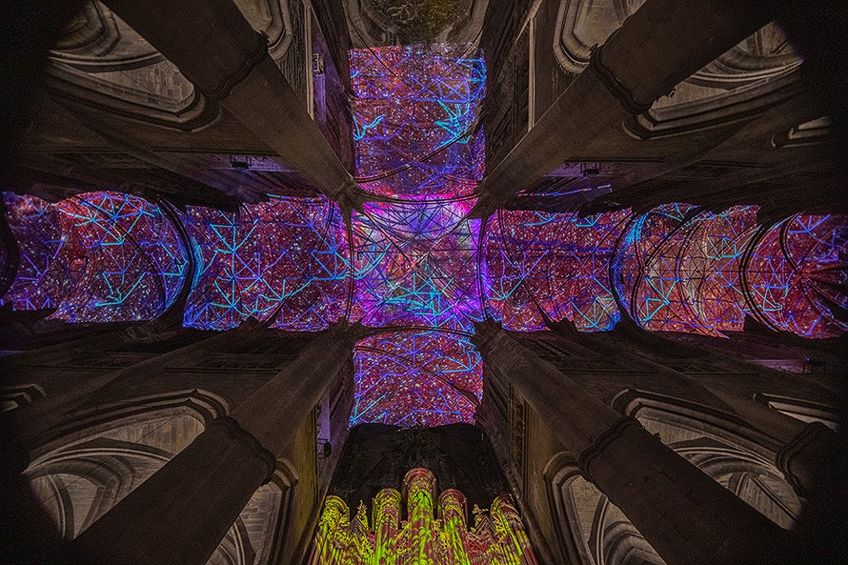
The emergence of computer art has enabled an even bigger and more copious expression of psychedelic vision in digital artworks that have since been created. The development of two-dimensional and three-dimensional graphics allowed unparalleled freedom to form when it came to digitally rendered versions of Psychedelic Art, as artists seem to be no longer limited by anything. Suddenly, even amateur artists had access to the technology needed to create digital Psychedelic Art, which broadened the accessibility of the movement entirely.
Despite this development, it has been argued that Psychedelia did not need to arrive at such a drastic stage of artistic progression. While changes in society, such as the introduction of drugs such as MDMA, encouraged artists to keep up, the drug culture has gotten a lot more dangerous than it was in the 1960s and 1970s. The introduction of newer drugs and computer art has led the entire Psychedelic Art movement off on a journey that it never intended to go on, with many true Psychedelic artists attempting to restore the genre to its previous glory.
The trippy art style of Psychedelic Art exists as an incredibly interesting movement to learn about. The artworks, with their captivating psychedelic patterns, colors, designs, and subject matter, remain as popular today as they were when they first emerged. Overlapping with the equally fascinating Pop Art movement, Psychedelic Art continues to remain relevant in art history, as many modern artworks and styles continue to borrow features of this iconic genre today.
Take a look at our Trippy Art webstory here!
Isabella studied at the University of Cape Town in South Africa and graduated with a Bachelor of Arts majoring in English Literature & Language and Psychology. Throughout her undergraduate years, she took Art History as an additional subject and absolutely loved it. Building on from her art history knowledge that began in high school, art has always been a particular area of fascination for her. From learning about artworks previously unknown to her, or sharpening her existing understanding of specific works, the ability to continue learning within this interesting sphere excites her greatly.
Her focal points of interest in art history encompass profiling specific artists and art movements, as it is these areas where she is able to really dig deep into the rich narrative of the art world. Additionally, she particularly enjoys exploring the different artistic styles of the 20th century, as well as the important impact that female artists have had on the development of art history.
Learn more about Isabella Meyer and the Art in Context Team.
Cite this Article
Isabella, Meyer, “Psychedelic Art – An Exploration of the Psychedelic Aesthetic in Art.” Art in Context. June 2, 2021. URL: https://artincontext.org/psychedelic-art/
Meyer, I. (2021, 2 June). Psychedelic Art – An Exploration of the Psychedelic Aesthetic in Art. Art in Context. https://artincontext.org/psychedelic-art/
Meyer, Isabella. “Psychedelic Art – An Exploration of the Psychedelic Aesthetic in Art.” Art in Context, June 2, 2021. https://artincontext.org/psychedelic-art/.


